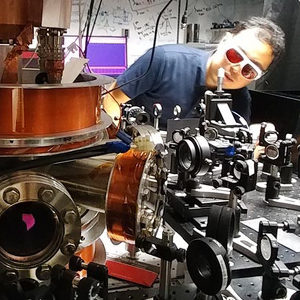Highlights
Limit-breaking frequency measurement could aid dark matter search
 Manas Mukherjee (left) and Tarun Dutta (right) report in npj Quantum Information a technique to use a single trapped ion to search for dark matter.
Manas Mukherjee (left) and Tarun Dutta (right) report in npj Quantum Information a technique to use a single trapped ion to search for dark matter.
Dark matter remains one of physics’ greatest mysteries. CQT researchers have proposed a new technique to search for this unknown ingredient of the universe using a novel scheme for precise measurement of particle interactions using quantum information science.
Scientists have posited the existence of various kinds of dark matter particles because our current theory of gravity cannot explain some astronomical observations about the movement and structure of galaxies - unless these galaxies contain 85% unknown, unseen ‘dark matter’. Experiments searching for the constituents of this missing matter have so far been inconclusive.
In a paper published in January in npj Quantum Information, CQT Principal Investigator Manas Mukherjee and Research Fellow Tarun Dutta demonstrate how the enhanced sensitivity of a quantum probe can be a tool to detect a particular dark matter candidate - light mass axion-like particles (ALP).
Measuring the unknown
The scheme proposed by Manas and Tarun directly measures coupling between ALPs and an atomic electron. This is the first scheme of its kind. Other experiments look for dark matter interactions with nuclear spin.
“Since nothing is known about dark matter, nobody knows if it interacts mainly with electrons or mainly with the nucleus. We need to do all kinds of experiments,” says Manas. “What we did was different because this looks in particular for interaction of dark matter with electron axial moment or spin.”
The researchers prepared a single Barium ion to act as a quantum probe. They put the ion in a superposition of two energy states, which differ in the position of the atom’s valence electron. A laser drives this atomic transition.
Axion-like particles are predicted to interact with electron spin. This means the excited state of the ion would interact with the oscillating dark matter field, causing an oscillation in the relative phase between the states of the ion, that looks like noise caused by stray fields. Such noise can be detected because it pushes the ion's internal state out of phase with the laser.
Beating the Heisenberg limit
However, the interaction of light mass ALPs with electron spin, if they exist, is expected to be very weak. To make a probe sensitive enough to detect such a signal, Manas and Tarun applied a quantum feedback strategy.
As the electron spin interacts, the ion alternates between gaining and losing phase over time. The feedback strategy flips periods of phase loss into more gain. This means that the researchers can measure a bigger phase change in a given observation time. More information means more precise measurements.
The strategy means the probe can beat the expected ‘Heisenberg limit’, which says the best possible precision that can be achieved in a certain amount of time of observation, T, is inversely proportional to T.
“It is a fundamental limit,” says Manas. “So pushing the boundary may allow us to do something completely new.”
With their technique, the researchers show that the uncertainty in frequency measurement scales as 1/T1.75. This is better than the 1/T given by the Heisenberg Limit.
As a proof-of-principle experiment, Manas and Tarun simulated a dark matter interaction by adding a 50 kHz noise to the system. This frequency falls within the predicted effects of ALPs of certain mass. They estimate that the probe's sensitivity to signals at this frequency, given observations they made over 80 microseconds, mean that ALP interactions (if they exist) must have coupling strength lower than 400 GeV-1. Astronomical observations have set tighter constraints, but this method represents a direct test of the limit.
The next step, Manas shares, is to increase the number of atomic probes used to improve the sensitivity. This might work best with a gas cell – a glass container filled with the probe atom – instead of trapped ions. The technique used for detection remains the same.
Manas says, “We try to bridge the gap between quantum information and particle physics. I think there is large scope to explore how we can apply these techniques in quantum information to do more fundamental physics.”
Learn more
Related Stories
 | Dance like a neutrino: new quantum scheme to simulate particle oscillations March 20 2012 |
Better precision from a quantum thermometer November 25 2019 | |
 | Barium qubit promising for telecoms September 25 2017 |






